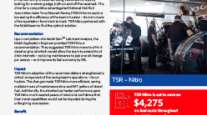Diesel Jumps 6.5¢ to $2.797
This story appears in the Jan. 11 print edition of Transport Topics.
The average price of U.S. retail diesel rose 6.5 cents a gallon last week to $2.797, the Department of Energy reported, and additional increases may be on the way as crude oil remained above $80 a barrel.
The diesel increase, from $2.732, was the largest one-week rise since Oct. 12, when the average jumped 10 cents. The retail gasoline average also climbed last week, moving up 5.8 cents to $2.665.
The price of West Texas Intermediate crude, the industry benchmark, soared to $83.52 before settling at $82.66 on Jan. 7. Just three weeks ago, on Dec. 14, it was $69.51.
Crude prices last closed above $80 a barrel on Nov. 4, 2009.
“We are very likely to see some additional increases over the next two weeks,” DOE analyst Tancred Lidderdale told Transport Topics on Jan. 6. “That is really being driven by the rise in the price of crude.”
The crude price rise coincides with the onset of colder-than-expected winter weather, which drives up demand for distillates that are also used for home heating oil, he said.
“Fuel is a big problem,” Tony Petruzzello, CEO of less-than-truckload carrier Petruzzello Transport Inc., Bethany, Conn., told TT.
“The biggest problem is the fluctuation. You can never be sure which way prices will go.”
Fuel price increases are hitting particularly hard in Petruzzello’s part of the country. New England prices last week were $2.935, the highest in the nation other than California.
The difference of nearly 14 cents a gallon in New England from the national average last week has widened from about 7 cents a gallon in November.
Another issue, Petruzzello said, is the difficulty in passing on fuel surcharges to customers when “there are some small carriers who are hanging on by their fingernails, and they don’t charge it at all.”
Currently, Petruzzello’s surcharge is about 30% on the rates charged by his firm, which operates 10 tractors and 18 trailers within a 200-mile radius of the company’s headquarters near New Haven.
Surcharges are an issue for several other reasons, he said. One issue is that the company has difficulty collecting the full 30% when rivals are willing to accept less.
Petruzzello’s surcharge, like that of many other carriers, is based on regional average DOE prices, which presents another challenge.
The difficulty arises because his fleet buys fuel in Connecticut, where the state tax is 40 cents a gallon, 15 cents above the regional average used to compute the DOE price.
Customers often balk when Petruzzello seeks to collect a surcharge based on the Connecticut price, he said.
The recent changes left diesel prices 22%, or 50.6 cents a gallon, below the corresponding month of 2009. Gasoline prices have jumped 58%, or 98.1 cents a gallon, in the same interval.
DOE’s Lidderdale said a $1 boost in crude typically raises diesel prices by 2.4 cents a gallon, and it usually takes one to three weeks for an increase in crude to show up at the pump.
Applying those patterns to recent price moves, diesel could soon top $3 a gallon. That could happen based on the rise of more than $11 a barrel in crude, which equates to adding 26.4 cents a gallon to the $2.748-a-gallon average retail price when crude was below $70 a barrel on Dec. 14.
Deutsche Bank analyst Justin Yagerman said in a Jan. 5 report that rising fuel prices add another cost burden on top of other expenses.
“With trucking companies entering the seasonally slower period of freight demand, and looming cash flows (such as annual insurance payments and tractor registrations) on the horizon for carriers, capacity reductions may accelerate in 2010,” his note said.
Yagerman also noted that diesel prices that fell during November and December now are 78 cents a gallon, or 39%, above the 2009 low of $2.017 a gallon on March 16.
Recent inventory trends also are adding to the short-term upward pressure on prices, Lidderdale said, because the supply of distillates used for diesel fuel fell 9 million barrels in December, countering the typical in-crease of 8 million barrels during that month in recent years.
Petruzzello expressed another frustration, saying that one of his customers was able to collect federal aid after 200 people were laid off and their jobs were outsourced overseas.
“If they can get aid for that, why can’t I get something like that as well?” he asked.




